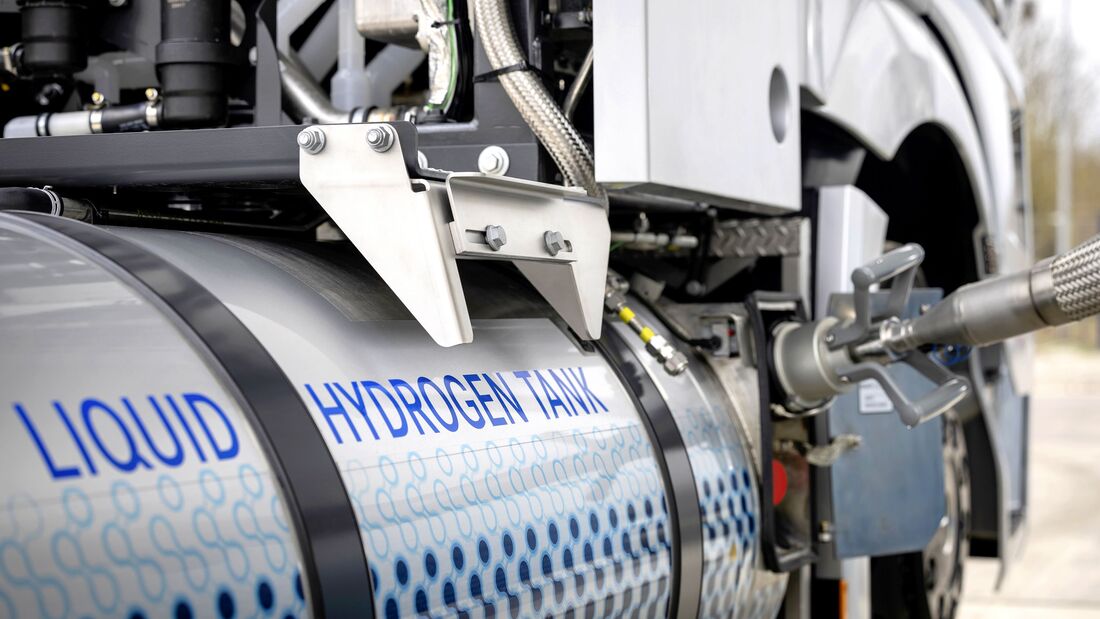In order for hydrogen propulsion to be convincing, a number of hurdles still need to be overcome. Hydrogen must first become available in large quantities and has to become cheaper. In addition, it must not be "grey", i.e. produced from fossil fuels with high CO2 emissions, but at least "blue" by storing the CO2 generated in the process. Later, based on renewable energies, it will finally be completely "green". But that's not all: The hydrogen must also be able to be carried in sufficient quantities in the truck for a long range and be quick and easy to refuel. But this is precisely where there are still problems with the combination of standard tractor units, which provide engineers with little installation space, and the currently common gaseous hydrogen under 350 or 700 bar pressure. The pressure tanks are voluminous and usually have to be stacked behind the driver's cab to achieve a usable range. In addition, the storage density is not so high that it could significantly outperform battery-electric trucks in the range chapter.
The solution for Daimler Truck: liquid hydrogen (LH2), which is around minus 250 degrees cold in the vehicle tank at 7 to 16 bar pressure and thus has a higher storage density. In 2023, the company used this very fuel to drive 1,047 kilometers from Wörth to Berlin for the GenH2 record run with just one tank of fuel. The usable 80 kilos in its double tanks were more than enough for the tractor unit despite the fully loaded trailer.
Electricity consumption of 0.05 kWh per kilo of hydrogen
The sLH2 refueling technology (where sLH2 stands for subcooled liquid hydrogen) developed with Linde Engineering is also intended to simplify handling, make it cheaper and more energy efficient. Using the example of the first public sLH2 filling station at the gates of the Daimler Truck Test and Development Center in Wörth, there is talk of an electricity consumption of 0.05 kWh per kilo of hydrogen filled up, a reduction of 95 percent compared to gaseous hydrogen. An sLH2 filling station also requires fewer vulnerable components and takes up less space. For Linde Engineering boss Jürgen Nowicki, liquid hydrogen for trucks is also only logical, as transport to the filling station is already usually managed in liquid form, because this means - keyword storage density - more hydrogen can be transported per tanker. And the detour of evaporation and subsequent pressurization for 350 or 700 bar vehicles is also eliminated without replacement. With the sLH2 technology, the truck does not even have to communicate with the filling station via software, goodbye to another source of error! Protective clothing, as with liquefied natural gas (LNG), is also not necessary at the sLH2 filling station, and contact with the low temperatures is impossible due to the continuous insulation.
Otherwise, the effort is greater than for LNG, but less than for gaseous hydrogen: the liquid hydrogen tanks on the truck must be better insulated than LNG reservoirs, but they are lighter and cheaper than carbon fiber storage for gaseous hydrogen. As in the case of LNG, fuel is drained in a controlled manner after three to four days of downtime to counteract the increasing pressure inside. However, typical long-distance use should be possible without losses. Refueling, in turn, takes around 10 to 15 minutes - for a range of 1,000 kilometers. The aim of Linde Engineering and Daimler Truck is now to jointly establish the new sLH2 standard throughout the industry. For this reason, the details of the technology are freely available to all interested parties via a standardized ISO standard. “We are now calling on other truck manufacturers and infrastructure companies to follow our approach and work together to make this technology the industry standard,” says Daimler Truck Technology Board Member Dr. Andreas Gorbach.






